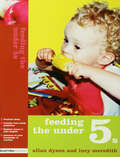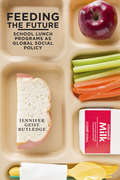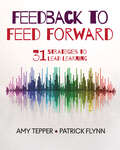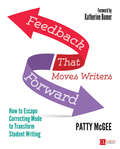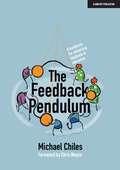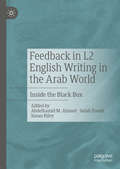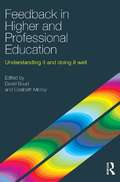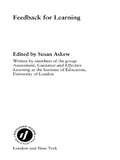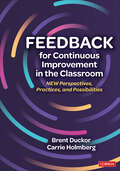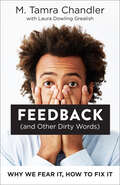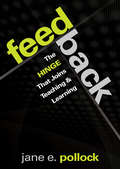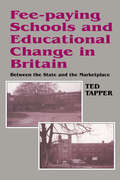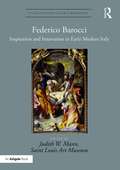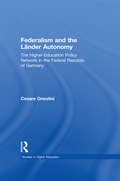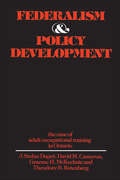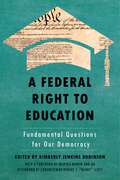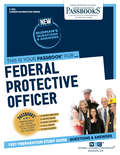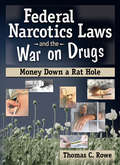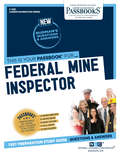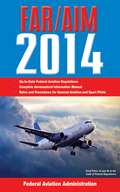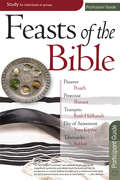- Table View
- List View
Feeding the Under 5s
by Allan Dyson Lucy MeredithOne young child in every four is overweight and one in ten is obese, some of the reasons for this are: a general lack of interest and understanding of food and cooking junk food being consumed every day a more sedentary school life. As a key issue that needs to be tackled early, starting with the under fives, this book offers: advice and recipe ideas for feeding young children properly ways to improve young children’s understanding of food and nutrition contemporary evidence and policies recommended by expert advisory bodies underlying reasons behind nutritional guidelines and food safety advice, and practical ways to implement them. The authors present all of this in plain English without assuming any prior knowledge of nutrition, food safety or health issues.
Feeding the Future: School Lunch Programs as Global Social Policy
by Jennifer Geist RutledgeA century ago, only local charities existed to feed children. Today 368 million children receive school lunches in 151 countries, in programs supported by state and national governments. In Feeding the Future, Jennifer Geist Rutledge investigates how and why states have assumed responsibility for feeding children, chronicling the origins and spread of school lunch programs around the world, starting with the adoption of these programs in the United States and some Western European nations, and then tracing their growth through the efforts of the World Food Program. The primary focus of Feeding the Future is on social policy formation: how and why did school lunch programs emerge? Given that all countries developed education systems, why do some countries have these programs and others do not? Rutledge draws on a wealth of information--including archival resources, interviews with national policymakers in several countries, United Nations data, and agricultural statistics--to underscore the ways in which a combination of ideological and material factors led to the creation of these enduringly popular policies. She shows that, in many ways, these programs emerged largely as an unintended effect of agricultural policy that rewarded farmers for producing surpluses. School lunches provided a ready outlet for this surplus. She also describes how, in each of the cases of school lunch creation, policy entrepreneurs, motivated by a commitment to alleviate childhood malnutrition, harnessed different ideas that were relevant to their state or organization in order to funnel these agricultural surpluses into school lunch programs. The public debate over how we feed our children is becoming more and more politically charged. Feeding the Future provides vital background to these debates, illuminating the history of food policies and the ways our food system is shaped by global social policy.
Feedback to Feed Forward: 31 Strategies to Lead Learning
by Patrick Flynn Amy TepperFeedback that works—for leadership that makes a difference. Leaders know that feedback is essential to teacher development. Crafting the right feedback, however, can be daunting. This how-to book introduces a dynamic yet practical leadership model that helps leaders in all roles and at all experience levels conduct comprehensive observations, analyze lessons for effectiveness, and develop high-leverage action steps that change practices and outcomes. Features include Comprehensive explanations of standards and discrete core skills Explicit think-alouds, ready-to-use strategies, and field-tested lesson examples Evidence-collection notes—with templates—from live observations Feedback samples across grade levels and content areas Reblicable case studies for professional learning
Feedback to Feed Forward: 31 Strategies to Lead Learning
by Patrick Flynn Amy TepperFeedback that works—for leadership that makes a difference. Leaders know that feedback is essential to teacher development. Crafting the right feedback, however, can be daunting. This how-to book introduces a dynamic yet practical leadership model that helps leaders in all roles and at all experience levels conduct comprehensive observations, analyze lessons for effectiveness, and develop high-leverage action steps that change practices and outcomes. Features include Comprehensive explanations of standards and discrete core skills Explicit think-alouds, ready-to-use strategies, and field-tested lesson examples Evidence-collection notes—with templates—from live observations Feedback samples across grade levels and content areas Reblicable case studies for professional learning
Feedback That Moves Writers Forward: How to Escape Correcting Mode to Transform Student Writing (Corwin Literacy)
by Patty McGeeStudent writing is only as good as the feedback we give In this remarkable book, Patty McGee shares research-based how-to’s for responding to writers that you can use immediately whether you use a writing program or a workshop model. Put down the red-pen, fix-it mindset and help your writers take risks, use grammar as an element of craft, discover their writing identities, elaborate in any genre, and more. Includes lots of helpful conference language that develops tone and trust and forms for reflecting on writing.
Feedback That Moves Writers Forward: How to Escape Correcting Mode to Transform Student Writing (Corwin Literacy)
by Patty McGeeStudent writing is only as good as the feedback we give In this remarkable book, Patty McGee shares research-based how-to’s for responding to writers that you can use immediately whether you use a writing program or a workshop model. Put down the red-pen, fix-it mindset and help your writers take risks, use grammar as an element of craft, discover their writing identities, elaborate in any genre, and more. Includes lots of helpful conference language that develops tone and trust and forms for reflecting on writing.
The Feedback Pendulum: A manifesto for enhancing feedback in education
by Michael ChilesIn the words of Bill Gates, 'We all need people who give us feedback. That's how we improve.' The art of giving feedback is widely recognised as one of the most powerful tools in education and equally one of the most variable aspects in the way it is applied. In The Feedback Pendulum, Michael aims to explore how the use of feedback has evolved over time, drawing on a combination of research and sharing experiences, and examples of best practices across the different phases of education to establish a culture of efficient and effective feedback that supports the teaching and learning cycle. This book will unpick the research, the experience of expert practitioners, and practical strategies in the different phases of education, including: the evolution of feedback over time; pre-school feedback; primary and secondary school feedback; specialist education feedback; parental feedback; and CPD feedback Through the use of spotlights from teachers and an education psychologist's perspective interweaved throughout, Michael provides a manifesto for enhancing feedback in education.
The Feedback Pendulum: A manifesto for enhancing feedback in education
by Michael ChilesIn the words of Bill Gates, 'We all need people who give us feedback. That's how we improve.' The art of giving feedback is widely recognised as one of the most powerful tools in education and equally one of the most variable aspects in the way it is applied. In The Feedback Pendulum, Michael aims to explore how the use of feedback has evolved over time, drawing on a combination of research and sharing experiences, and examples of best practices across the different phases of education to establish a culture of efficient and effective feedback that supports the teaching and learning cycle. This book will unpick the research, the experience of expert practitioners, and practical strategies in the different phases of education, including: the evolution of feedback over time; pre-school feedback; primary and secondary school feedback; specialist education feedback; parental feedback; and CPD feedback Through the use of spotlights from teachers and an education psychologist's perspective interweaved throughout, Michael provides a manifesto for enhancing feedback in education.
Feedback in L2 English Writing in the Arab World: Inside the Black Box
by Susan Riley Abdelhamid M. Ahmed Salah TroudiThis edited book uses case studies to offer a comprehensive picture of the feedback practices and perceptions pertinent to English as a Foreign Language (EFL) writing in the Arab world. It highlights essential themes about feedback in L2 writing in eight Arab countries, and offers a detailed critical analysis of feedback practices and perceptions in six of these: Egypt, Morocco, Oman, Saudi Arabia, Tunisia and the United Arab Emirates. The book will appeal to an international readership of academics, researchers and practitioners interested in EFL writing in the Arab world.
Feedback in Higher and Professional Education: Understanding it and doing it well
by David Boud Elizabeth MolloyLearners complain that they do not get enough feedback, and educators resent that although they put considerable time into generating feedback, students take little notice of it. Both parties agree that it is very important. Feedback in Higher and Professional Education explores what needs to be done to make feedback more effective. It examines the problem of feedback and suggests that there is a lack of clarity and shared meaning about what it is and what constitutes doing it well. It argues that new ways of thinking about feedback are needed. There has been considerable development in research on feedback in recent years, but surprisingly little awareness of what needs to be done to improve it and good ideas are not translated into action. The book provides a multi-disciplinary and international account of the role of feedback in higher and professional education. It challenges three conventional assumptions about feedback in learning: That feedback constitutes one-way flow of information from a knowledgeable person to a less knowledgeable person. That the job of feedback is complete with the imparting of performance-related information. That a generic model of best-practice feedback can be applied to all learners and all learning situations It seeking a new approach to feedback, it proposes that it is necessary to recognise that learners need to be much more actively involved in seeking, generating and using feedback. Rather than it being something they are subjected to, it must be an activity that they drive.
Feedback For Learning
by Susan AskewTeachers may be surrounded by feedback and involved in it every day, but the notion is poorly analysed and poorly used. Feedback for Learning provides an important collection of contributions to the highly topical theme of feedback to support learning.The book spans three major areas which affect all teachers:*young people's learning*teachers' learning *organisational learning.The authors critically examine the assumption that feedback necessarily has positive learning outcomes and describe models and practices which are more likely to result in effective learning at the individual, group and organisational level.
Feedback for Continuous Improvement in the Classroom: New Perspectives, Practices, and Possibilities
by Brent Duckor Carrie L. HolmbergPut feedback to work for everyone to make a difference—now Feedback connects, deepens communication, and helps everyone focus on advancing student learning. What if you could use the dimensions and facets of formative feedback in ways that emphasize authenticity, equity, and care for ALL students? Educators Brent Duckor and Carrie Holmberg show you how to plan, enact, and reflect on feedback practices within lessons and across units using an accessible, comprehensive, and innovative framework that illuminates the path towards equity and excellence for all. With evidence-based research and real classroom examples, Feedback for Continuous Improvement in the Classroom answers: What is formative feedback? How does it influence student outcomes and teacher pedagogy? Why are well-defined learning goals, aligned with rich tasks and progress guides, essential to making feedback truly formative? What are essential facets of teacher, peer, and self-driven feedback? How does feedback work best in whole-class, small group, or individual configurations? What can make written, spoken, and nonverbal feedback modalities more effective—for all? How can focusing on feedback improve learning across all subject matter disciplines? Prompts for self-reflection, videos, vignettes, and scaffolds throughout help readers see how effective feedback can be embedded into classrooms and school communities committed to discovery, growth, and deeper learning.
Feedback for Continuous Improvement in the Classroom: New Perspectives, Practices, and Possibilities
by Brent Duckor Carrie L. HolmbergPut feedback to work for everyone to make a difference—now Feedback connects, deepens communication, and helps everyone focus on advancing student learning. What if you could use the dimensions and facets of formative feedback in ways that emphasize authenticity, equity, and care for ALL students? Educators Brent Duckor and Carrie Holmberg show you how to plan, enact, and reflect on feedback practices within lessons and across units using an accessible, comprehensive, and innovative framework that illuminates the path towards equity and excellence for all. With evidence-based research and real classroom examples, Feedback for Continuous Improvement in the Classroom answers: What is formative feedback? How does it influence student outcomes and teacher pedagogy? Why are well-defined learning goals, aligned with rich tasks and progress guides, essential to making feedback truly formative? What are essential facets of teacher, peer, and self-driven feedback? How does feedback work best in whole-class, small group, or individual configurations? What can make written, spoken, and nonverbal feedback modalities more effective—for all? How can focusing on feedback improve learning across all subject matter disciplines? Prompts for self-reflection, videos, vignettes, and scaffolds throughout help readers see how effective feedback can be embedded into classrooms and school communities committed to discovery, growth, and deeper learning.
Feedback (and Other Dirty Words): Why We Fear It, How to Fix It
by M. Tamra Chandler Laura Dowling GrealishA practical and irreverent guide to taking the sting out of feedback and reclaiming it as a motivating, empowering experience for everyone involved. Feedback: the mere mention of the word can make our blood pressure rise and our defenses go up. For many of us, it's a dirty word that we associate with bias, politics, resentment, and self-doubt. However, if we take a step back and think about its true intent, we realize that feedback needn't be a bad thing. After all, understanding how others experience us provides valuable opportunities to learn and grow. Authors M. Tamra Chandler and Laura Grealish explain how feedback got such a bad rap and how to recognize and minimize the negative physical and emotional responses that can erode trust and shut down communication. They offer a new and more ambitious definition of feedback, explore the roles we each play as Seeker, Extender, and Receiver, and introduce the three Fs of making feedback focused, fair, and frequent. You'll also find valuable exercises and strategies, along with real-world examples that illustrate how you can put these ideas into action and join in the movement to fix feedback, once and for all.When it's done right, feedback has been proven to be the most effective means of improving communication and performance for you and your organization. It's too important to give up, and with Chandler and Grealish's help, you'll be able to use it deftly, equitably, and effectively.
Feedback: The Hinge That Joins Teaching and Learning
by Jane E. PollockWorks like an app to close the learning gap! Jane E. Pollock, coauthor of Classroom Instruction That Works, expands on the bestseller’s feedback strategy in this groundbreaking work. While feedback is not a new concept, what is new is using it the way people use computer apps—to set goals, track their progress, and regulate their own learning. With only a slight shift in teaching strategy, this no-cost technique: <p><p> Informs teachers while students are learning, not after <p> Engages and motivates learners <p> Teaches 21st-century skills <p> Helps students understand and meet standards
Fee-paying Schools and Educational Change in Britain: Between the State and the Marketplace
by Ted TapperExamining the history of access to private education this work sheds light on the interaction of state, society and schooling. Organized historically, much of the analysis concentrates on contemporary political struggles, and evaluates the possibility of a unified educational system.
Federico Barocci: Inspiration and Innovation in Early Modern Italy (Visual Culture in Early Modernity)
by Judith MannReviewers of a recent exhibition termed Federico Barocci (ca. 1533–1612), 'the greatest artist you’ve never heard of'. One of the first original iconographers of the Counter Reformation, Barocci was a remarkably inventive religious painter and draftsman, and the first Italian artist to incorporate extensive color into his drawings. The purpose of this volume is to offer new insights into Barocci’s work and to accord this artist, the dates of whose career fall between the traditional Renaissance and Baroque periods, the critical attention he deserves. Employing a range of methodologies, the essays include new ideas on Barocci’s masterpiece, the Entombment of Christ; fresh thinking about his use of color in his drawings and innovative design methods; insights into his approach to the nude; revelations on a key early patron; a consideration of the reasons behind some of his most original iconography; an analysis of his unusual approach to the marketing of his pictures; an exploration of some little-known aspects of his early production, such as his reliance on Italian majolica and contemporary sculpture in developing his compositions; and an examination of a key Barocci document, the post mortem inventory of his studio. A translated transcription of the inventory is included as an appendix.
Federalism and the Lander Autonomy: The Higher Education Policy Network in the Federal Republic of Germany, 1948-1998 (RoutledgeFalmer Studies in Higher Education)
by Cesare OnestiniAn interesting study of the German higher Education system, examining the development of higher education policies from the post-war years, to the post-unification period.
Federalism and Policy Development: The Case of Adult Occupational Training in Ontario
by David Cameron Graeme Mckechnie J. Stefan Dupre Theodore RotenbergIn 1966 the Canadian government announced the abrupt termination of a longstanding conditional grant relationship with the provinces in the domain of technical and vocational education. It sought to substitute a radically new arrangement whereby it would purchase occupational training for adults as an integral part of an over-all manpower policy. This book examines what ensued with particular reference to the province of Ontario and offers unique insights into the conduct of federal-provincial relations from the level of first ministers through that of operating officials down to the grass roots of individual Canadian communities. It also assesses the opportunities and limitations attendant upon a major departure in manpower policy. By focusing on the role of public servants with quite distinct professional orientations – economists and educationists – the book yields new insights into the contribution of appointed specialists to policy development.
A Federal Right to Education: Fundamental Questions for Our Democracy
by Congressman Robert ScottHow the United States can provide equal educational opportunity to every child The United States Supreme Court closed the courthouse door to federal litigation to narrow educational funding and opportunity gaps in schools when it ruled in San Antonio Independent School District v. Rodriguez in 1973 that the Constitution does not guarantee a right to education. Rodriguez pushed reformers back to the state courts where they have had some success in securing reforms to school funding systems through education and equal protection clauses in state constitutions, but far less success in changing the basic structure of school funding in ways that would ensure access to equitable and adequate funding for schools. Given the limitations of state school funding litigation, education reformers continue to seek new avenues to remedy inequitable disparities in educational opportunity and achievement, including recently returning to federal court. This book is the first comprehensive examination of three issues regarding a federal right to education: why federal intervention is needed to close educational opportunity and achievement gaps; the constitutional and statutory legal avenues that could be employed to guarantee a federal right to education; and, the scope of what a federal right to education should guarantee. A Federal Right to Education provides a timely and thoughtful analysis of how the United States could fulfill its unmet promise to provide equal educational opportunity and the American Dream to every child, regardless of race, class, language proficiency, or neighborhood.
Federal Protective Officer: Passbooks Study Guide (Career Examination Series)
by National Learning CorporationThe Federal Protective Officer Passbook® prepares you for your test by allowing you to take practice exams in the subjects you need to study. It provides hundreds of questions and answers in the areas that will likely be covered on your upcoming exam.
Federal Narcotics Laws and the War on Drugs: Money Down a Rat Hole
by Thomas C RoweWe&’re losing the "war on drugs"-but the fight isn&’t over yetFederal Narcotics Laws and the War on Drugs examines our current anti-drug programs and policies, explains why they have failed, and presents a plan to fix them. Author Thomas C. Rowe, who has been educating college students on recreational drug use for nearly 30 years, exposes the truth about anti-drug programs he believes were conceived in ignorance of the drugs themselves and motivated by racial/cultural bias. This powerful book advocates a shift in federal spending to move funds away from the failed elements of the "war on drugs" toward policies with a more realistic chance to succeed-the drug courts, education, and effective treatment. Common myths and misconceptions about drugs have produced anti-drug programs that don&’t work, won&’t work, and waste millions of dollars. Federal Narcotics Laws and the War on Drugs looks at how-and why-this has happened and what can be done to correct it. The book is divided into "How did we get into this mess?" which details the history of anti-narcotic legislation, how drug agencies evolved, and the role played by Harry Anslinger, Commissioner of the United States Bureau of Narcotics from 1930 to 1962; "What works and what doesn&’t work," which looks at the failure of interdiction efforts and the negative consequences that have resulted with a particular focus on the problems of prisons balanced against the drug court system; and a third section that serves as an overview of various recreational drugs, considers arguments for and against drug legalization, and offers suggestions for more effective methods than our current system allows.Federal Narcotics Laws and the War on Drugs also examines: the creation of the Federal Bureau of Narcotics current regulations and structures current federal sentencing guidelines current state of the courts and the prison system mandatory sentencing and what judges think interdiction for heroin, cocaine and crack cocaine, and marijuana early education efforts the DARE program drug use trends drug treatment models the debate over legalizationFederal Narcotics Laws and the War on Drugs also includes several appendices of federal budget figures, cocaine and heroin purity and price, and federal bureau of prisons statistics. This unique book is required reading for anyone concerned about the drug problem in the United States and what is-and isn&’t-being done to correct it.
Federal Mine Inspector: Passbooks Study Guide (Career Examination Series)
by National Learning CorporationThe Federal Mine Inspector Passbook® prepares you for your test by allowing you to take practice exams in the subjects you need to study. It provides hundreds of questions and answers in the areas that will likely be covered on your upcoming exam, including but not limited to: Fundamentals of mining, drilling and subsurface conditions; inspection techniques; safety and report writing.
Federal Aviation Regulations/Aeronautical Information Manual 2014: Federal Aviation Regulations/aeronautical Information Manual (Far/aim: Federal Aviation Regulations And The Aeronautical Information Manual Ser.)
by Federal Aviation AdministrationIf you’re an aviator or aviation enthusiast, you cannot be caught with an out-of-date edition of the FAR/AIM. In today’s environment, there is no excuse for ignorance of the rules of the US airspace system. In the newest edition of the FAR/AIM, all regulations, procedures, and illustrations are brought up to date to reflect current FAA data. This handy reference book is an indispensable resource for members of the aviation community, as well as for aspiring pilots looking to get a solid background in the rules, requirements, and procedures of flight training. Not only does this manual present all the current FAA regulations, it also includes: A study guide for specific pilot training certifications and ratings A pilot/controller glossary Standard instrument procedures Parachute operations Airworthiness standards for products and parts The NASA Aviation Safety reporting form Important FAA contact informationThis is the most complete guide to the rules of aviation available anywhere. Don’t take off without the FAR/AIM!
Feasts of the Bible Participant Guide
by Sam NadlerThis is the companion participant guide to the Feasts of the Bible 6-Session DVD-based Study.It gives the participant discussion questions, quizzes, a place for taking notes and listing prayer requests, additional Old Testament information about types of offerings, the role of the priests, the meaning of Jesus' teaching that he was "Lord of the Sabbath," and more. Includes a calendar of the feasts (they change dates each year) and diagrams and charts for the tabernacle and the feasts of the Lord.Some Christians miss the importance of the biblical feasts, seeing them as merely "Jewish" holidays, but Scripture says these are the Feasts of the Lord God established for all people for all time. Now you can connect the Hebrew roots of Christianity and the symbolism that points to Jesus Christ using this6-session DVD-based study and Participation Guide, The Feasts of the Bible, sold seperately.
